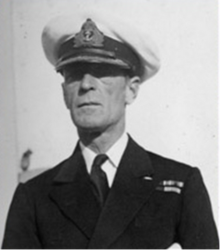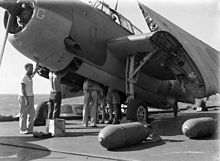Operation outflank

Fighter planes and bombers from the Indefatigable line up to attack the Pangkalan Brandan oil refinery in Sumatra
| date | November 18, 1944 to January 24, 1945 |
|---|---|
| place | Padang , West Sumatra |
| output |
| Parties to the conflict | |
|---|---|
| Commander | |
|
|
|
Operation outflank was the generic term for four carrier-based air attacks of the British Eastern Fleet on targets in West Sumatra during the Pacific War in World War II .
planning
As the successor to Rear Admiral Clement Moody , Rear Admiral Philip Vian took over command of a task force of the Eastern Fleet from Admiral Bruce Fraser in November 1944 .
The task force consisted of the aircraft carriers Illustrious and Indomitable , the light cruiser Newcastle , the light anti-aircraft cruisers Argonaut and Black Prince , and the destroyers Kempenfelt , Wakeful , Wessex , Whirlwind and Wrangler .
Operation outflank
A first operation under the code name "Outflank" began on November 17, 1944 when the task force of the British Eastern Fleet under Rear Admiral Vian left Trincomalee . He had the destruction of oil refineries on Sumatra as a goal, as well as three other operations, which were summarized under the heading "Outflank". The fleet was oiled from the tanker Wave King on November 18. The two destroyers Wager and Whelp stood ready to secure the operation.
On the morning of November 20, the starting position for the attack was reached. 27 Avenger bombers and 28 Corsair and Hellcat fighters launched an attack on Pangkalan Brandan in northwest Sumatra, around 65 km northwest of Medan . Due to the bad weather, the attack had to be stopped there. The oil installations in the port of Belawan Deli served as an alternative target . Since low clouds and gusty winds made the attack more difficult, the planes did little damage. Another attack in the afternoon against the airfield near Sabang was unsuccessful.
The fleet ran back to Ceylon on November 23.
Operation Robson
With the TF 67, consisting of the aircraft carriers Indomitable and Illustrious , the cruisers Newcastle , Black Prince and Argonaut and the destroyers Kempenfelt , Wager, Wakeful, Wessex, Whelp, Whirlwind and Wrangler, Rear Admiral Vian carried out further attacks on December 17 and 20 against the oil refineries, as well as the railway and port facilities of Belawan-Deli. Again the bad weather hampered the attack. An attack on the oil facilities near Medan was also unsuccessful.
Operation Lentil
The newly formed Task Force 63 under Rear Admiral Vian consisted of the aircraft carriers Indomitable , Victorious and Indefatigable , the cruisers Suffolk , Ceylon , Argonaut, Black Prince and the destroyers Kempenfelt, Whelp, Wager, Grenville , Urania , Undaunted , Undine and Ursa .
On January 4, 1945, Rear Admiral Vian carried out another attack on the Pangkalan-Brandan oil refineries with her. From the carriers launched 27 Avenger bombers which were accompanied by 28 Hellcat and Corsair fighters.
The Avengers could cause considerable damage in better weather. However, a number of Hellcat and Corsair fighters lost themselves in fierce aerial battles with the Japanese, so that the bombers often had to fly unprotected attacks. In addition, poor radio traffic hindered the operation. However, the Japanese failed to take advantage of these mistakes. The British lost a machine in the attack.
Operation Meridian
prehistory
The Eastern Fleet was ordered to Australia in January 1945 to prepare for battle with the Americans in the Pacific . At a meeting in Hawaii between the admirals Fraser and Nimitz , the further course of action in the fight against Japan was discussed. Since Nimitz could not rule out that the British Pacific Fleet could be ordered to the Southwest Pacific to support General MacArthur , he asked Fraser to divert the British Pacific Fleet on its way to Australia in order to start a major attack on the oil refineries in southern Sumatra on their way . Fraser agreed, and the result was the largest operation by the British carrier fleet during World War II; a double-led attack to shut down facilities south of Palembang.
The attacks
The largest British carrier fleet in the entire Second World War was put together for the company. Not least in order to achieve a clout that should be on a par with that of the US carrier fleets. Therefore, the fleet had the maximum number of aircraft that could fit on the flight decks. The USA managed to start 72 planes within 35 minutes; something the British had never succeeded in doing. The British aircraft carriers were not designed for such quick takeoffs. The US carriers had open hangars and side elevators so that the aircraft's engines could warm up below deck.
The Task Force 63 consisted of the carriers Indomitable , Indefatigable , Victorious and Illustrious , the battleship King George V . under the command of Vice Admiral Bernard Rawlings , the cruisers Black Prince, Argonaut, Euryalus , and the destroyers Grenville, Undine, Ursa, Undaunted, Kempenfelt, Wakeful, Whirlwind, Wager and Whelp. The cruiser Ceylon and the destroyer Wessex joined later.
The operation began on January 16 with the transfer of Task Force 63 from Trincomalee to the Pacific. The oiling was carried out by the tankers Echodale , Wave King and Empire Salvage on January 20 , covered by the destroyer Urchin . Later the tanker Arndale , coming from Fremantle , joined them. The submarines Sturdy , Tantivy and Tantalus took over the reconnaissance and were available for sea rescue cases.
Due to bad weather, the fighter planes could not fly the first attacks as planned from January 21 to 23. Only start on January 24, 43 and 12 Avenger bombers Firefly fighter-bombers with missiles accompanied by 50 Hellcat-, Corsair- and Seafire -Jägern to attack the oil refinery of Pladjoe , north of Palembang .
At the destination, the planes were unexpectedly confronted with blocking balloons for which there was no plan. Now the use of an attack coordinator, which was used for the first time, paid off. His job was to direct the attacks of the various squadrons and to react to unexpected events. So the coordinator gave the order to the Fireflies to attack the balloons, but received no response over the radio. The unreliable radio was a big problem, as some plan changes could not reach the approaching bombers.
Despite all the obstacles, the attack was a success. Surprised by the British, the Japanese only launched 20 fighters, 14 of which were shot down. 38 machines were also destroyed on the ground. The British lost seven aircraft in combat and an additional 25 by crash landings.
The second attack started on January 29th with an approach of 48 Avengers, ten Fireflies, 24 Corsairs and 16 Hellcats to attack the Soengi-Gerong oil refineries near Palembang. Through early reconnaissance, a Japanese squadron of fighters succeeded in intercepting the approaching aircraft southwest of the refineries. The British shot down 30 Japanese planes in the aerial battles. In addition, 38 machines standing on the ground were destroyed. The task force itself came under Japanese bomber fire when twelve bombers were able to get through to it. However, all bombers were shot down by the on-board flak or fighters. The British lost a total of 16 aircraft. Some crews could be saved.
On February 4th, the task force arrived in Fremantle.
consequences
Operation Meridian was the first British operation in which four aircraft carriers were used offensively. Admiral Fraser countered the critics that the Palembang attacks had welded the fleet together into a combat unit and was ready for Allied operations in the Pacific.
The oil refineries in and around Palembang were unable to deliver aviation fuel for the next two months , and even after that they never reached the level they had before the attacks.
Individual evidence
- ↑ a b Christopher Chant: The Encyclopedia of Codenames of World War II . Verlag Routledge Kegan & Paul, 1987, ISBN 978-0-7102-0718-0 (English, codenames.info [accessed July 8, 2020]).
- ↑ a b c d Jürgen Rohwer: Chronicle of the Naval War 1939-1945. Württemberg State Library Stuttgart 2007 to 2020, accessed on July 8, 2020 .
- ↑ a b c d e f g h Jon Robb-Webb: The British Pacific Fleet Experience and Legacy, 1944-50 . Routledge, London and New York 2016, ISBN 978-1-138-27495-2 , pp. 110 ff . (English, google.de [accessed on July 10, 2020]).
- ↑ a b c d Jürgen Rohwer: Chronicle of the Naval War 1939-1945. Württembergische Landesbibliothek Stuttgart 2007 to 2020, accessed on July 10, 2020 .
- ↑ Operation Meridian. In: Trial by Fire - Armored flight deck aircraft carrier action and damage reports, 1940-1945. Retrieved July 10, 2020 .
Web links
- Dr Tim Benbow: British Naval Aviation: The First 100 Years . Ashgate, 2011, ISBN 978-1-4094-0612-9 , pp. 104 ff . (English, google.de [accessed on July 12, 2020]).



